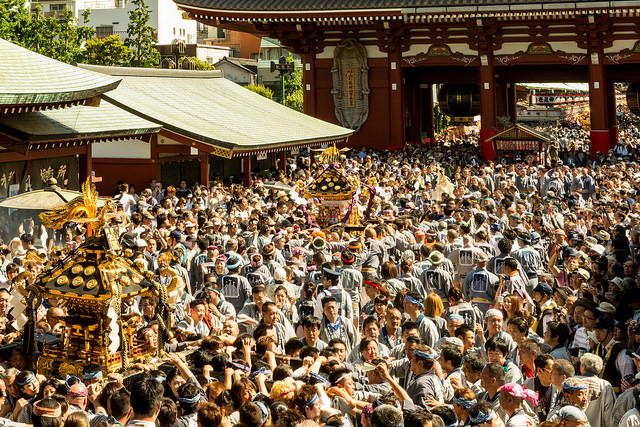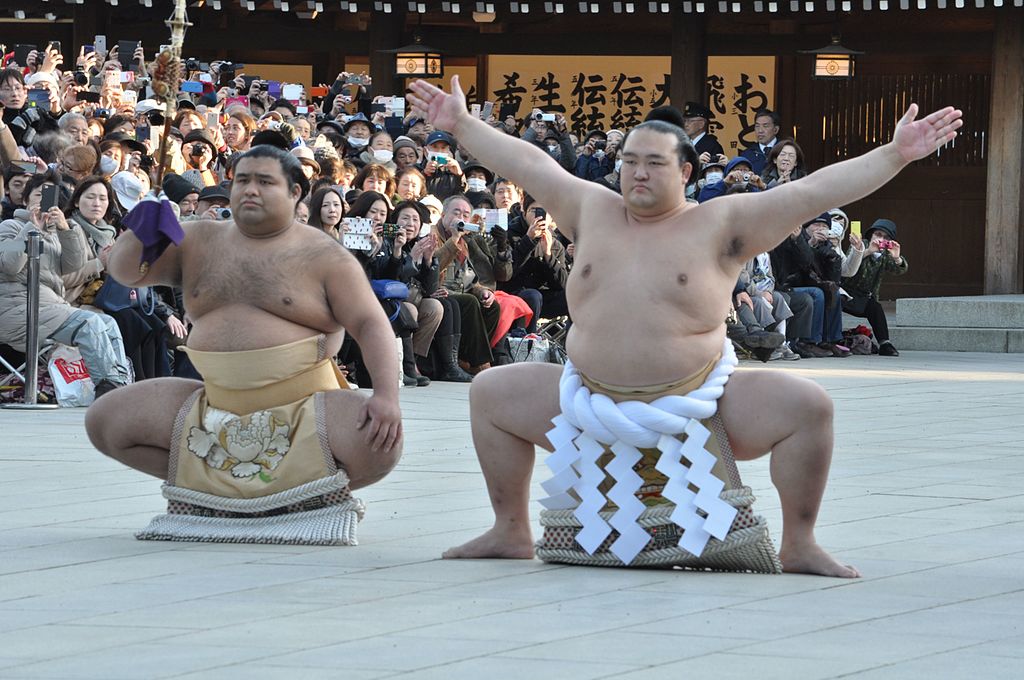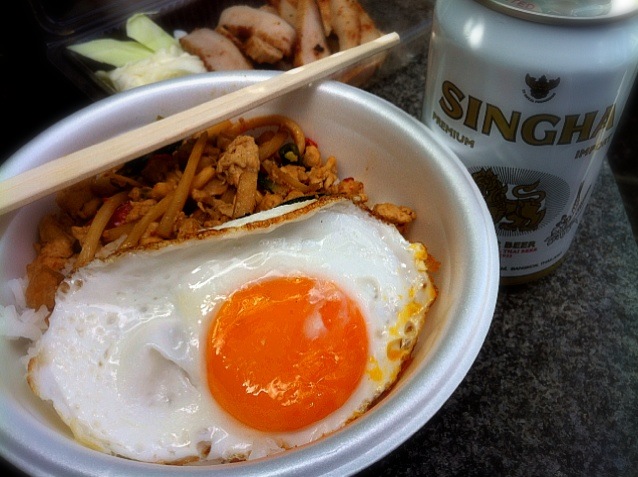Apr 20, 2018
Sanja Matsuri, Tokyo’s Wildest Festival

Tokyo has many festivals, and particularly as we head towards the summer months they will be coming thick and fast. But none are quite so wild as Sanja Matsuri in Asakusa.
The History of Sanja Matsuri
On the morning of March 18, 628 CE, so the story goes, two fisherman brothers, Hinokuma Hamanari and Hinokuma Takenari, found tangled in their nets a statue of the Bodhisattva Kannon, the Goddess of Mercy. Upon hearing this the chief of their village, Hajino Nakatomo, approached the fishermen, converted them to Buddhism and took the statue into his home. That home was the beginnings of Senso-ji Temple, Tokyo’s oldest temple and one of its most important. Alongside this temple is Asakusa Shrine where the three men are enshrined.
Although there is evidence to suggest that the festival has its origins in around the 7th century, its current form was established during the Edo period (1603-1868). Today it draws somewhere in the region of two million visitors, and is considered one of the ‘big three’ festivals of Tokyo.
The Festivities of Sanja Matsuri
The Sanja Matsuri is spread over three days on the third weekend of May, with festivities kicking off on the Friday. At around 1pm priests, geisha, musicians, dancers and the city’s officials form a parade along Yanagi dori to the temple and shrine dressed in traditional garb. Following this there is a traditional prayer and dance called Binzasara Mai for an abundant harvest for the neighborhood’s descendants, and the first of the ‘mikoshi’ portable shrines are carried through the streets.
The following day more of these portable shrines – 100 representing the 44 districts of the Asakusa neighborhood including smaller women’s mikoshi and children’s mikoshi – are brought to the shrine to be blessed and then return through the crowded streets to spread the prosperity to the area. As they are carried the shrines are jolted violently to intensify the power of the deities within.
On the final day of the festival, Sunday, representatives from the 44 districts compete within Senso-ji Temple for the right to carry the three main mikoshi, representing the three men who founded the temple over 1,300 years ago. As they do so they jostle and wrestle with each other, and this violence means that spectators are not permitted within the temple.
Eventually after two hours of competition the three mikoshi are brought out to visit every street and shopping arcade of the Asakusa neighborhood before returning to the temple.
About Asakusa
For many centuries, Asakusa was Tokyo’s predominant entertainment district, and when still located outside the city limits it was the site of kabuki theaters and a large red light district. Today it is the centre of Tokyo’s ‘shitamachi’ (“low city”) where an atmosphere of the Tokyo’s past remains in tact.
Along Nakamise-dori Street, running along the approach to Senso-ji Temple, there are many small, old shops carrying an array of articles made from Japanese paper and other traditional goods such as folding fans. It is a quaint shopping street that attracts many visitors.
Though the entertainment district was mostly destroyed during World War Two, some of its popularity has returned thanks to tourists visiting these traditional streets, the arrival of the nearby Tokyo Skytree, and the Sendo-ji Temple.
Sanja Matsuri 2018
Starts on May 20th in 2018.
Asakusa Shrine
2 Chome-3-1 Asakusa, Taitō-ku, Tōkyō-to 111-0032 (map link)
asakusajinja.jp
03-3844-1575
2 minutes’ walk from Asakusa Station on the Tobu Skytree, Toei Asakusa, and Tokyo Metro’s Ginza Lines.
Mark Guthrie
Image: flickr.com “Sanja Matsuri” by Yoshikazu TAKADA (CC BY-NC-SA 2.0)
Apr 17, 2018
Tokyo Summer Sumo Basho 2018

Out of the six annual grand tournaments of sumo wrestling, Tokyo hosts three. Of those the Tokyo Summer Sumo Basho in May in particular is an experience like none other! For fifteen days all levels of athletes show up and hope to advance along in the tournament, while their fans fill the stadium with their enthusiasm and applause.
For this tournament each day begins early with sumo matches that run back-to-back until the evening. Spectators and fans tend to purchase tickets for a day or more and come and go throughout the day, leaving room for breaks as needed. For the mornings, the wrestlers tend to be among the lower ranks with skill level and excitement progressing as the day goes on. Starting around 2:00 p.m., the top-division wrestlers begin making their appearances in the ring. Towards the end of the day, the atmosphere of the stadium really picks up as the top-ranked wrestlers face off for some of their most beloved fans and the chance to advance to the division title-holder match.
The winner of this tournament, at the end of the 15 days, will be the new division champion. This champion has the opportunity to advance to compete in higher divisions throughout the year to try for the title of the top ranking sumo wrestler, or Yokozuna. This title has been awarded to less than 100 wrestlers since the start of these tournaments in the 17th Century.
Tickets can be purchased at any time at the self-service kiosks located near the main gate of Kokugikan. There is a 1,000 yen service fee charge to use these machines, and then the prices vary depending on where your preferred seats are located in the stadium. The three levels of pricing are: ringside seats, box seats, and general admission seating. For general admission seating, tickets can only be purchased at the arena’s box office on the day of the match.
Tokyo Summer Sumo Basho 2018
When: May 13 to May 27, 9:00 a.m. to 6:00 p.m.
Where: Ryogoku Kokugikan (328 1-Chome, Yokoami, Sumida Ward, Tokyo 130-0015)
Pricing varies, see the site for details:
Ringside seats (these go immediately): 14,800 yen
…
General admission seating (you can pretty much always get these): 2,200 yen
Ticket information website: http://sumo.pia.jp/en/sumo05.jsp
Reference Website: http://www.japan-talk.com/jt/new/sumo-summer-basho
Photo by 江戸村のとくぞう (Own work) [CC BY-SA 4.0], via Wikimedia Commons
Apr 10, 2018
Thai Festival in Tokyo

The annual Thai Festival in Tokyo’s Yoyogi Park is a great place to find excellent Thai food, as well as enjoy a diverse stage schedule including martial arts demonstrations, musicians, dancers, and artists. The festival’s main selling point is Thai food and drink, in copious quantities, prepared by virtually every Thai food restaurant in Tokyo, but you can find a great deal more than that!
Whether you are after pad-thai, green pappaya salad, or just a few Singha beers, you will find them all here, as well as a diverse array of entertainment and cultural opportunities.
Tokyo Thai Festival 2018
Saturday May 12 , Sunday May 13
10:00 – 20:00
www.thaifestival.net
Yoyogi Park, Tokyo (Google map)
By hirotomo t (https://www.flickr.com/photos/travelstar/7180212710) [CC BY 2.0], via Flickr



